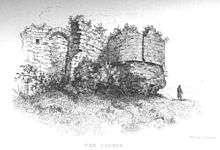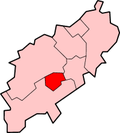Northampton Castle
| Northampton Castle | |
|---|---|
| Northampton, England | |
|
All that remains of Northampton Castle: a postern that was dismantled from its original position and rebuilt into the wall of Northampton railway station | |
 Northampton Castle | |
| Coordinates | 52°14′13″N 0°54′18″W / 52.237°N 0.905°WCoordinates: 52°14′13″N 0°54′18″W / 52.237°N 0.905°W |
| Type | Motte-and-bailey castle |
| Site information | |
| Condition | Destroyed |
| Site history | |
| Built | 1084 |
| Built by | Simon de Senlis |
Northampton Castle was one of the most famous Norman castles in England.[1] It was built under the stewardship of Simon de Senlis, the first Earl of Northampton, in 1084. It took several years to complete, as there is no mention of it in the Domesday Book, a great survey of England completed in 1086. The castle site was outside the western city gate, and defended on three sides by deep trenches. A branch of the River Nene provided a natural barrier on the western side. The castle had extensive grounds and a large keep. The gates were surrounded by bulwarks made of earth, used to mount artillery. The castle was 'obliterated' by the arrival of a railway branch of what is now the West Coast Main Line in the 19th century, the station of which was built on the castle site[1] and the construction of the original Northampton Castle railway station.


History
Early period
In the reign of Henry II, the castle was in the hands of the Crown. In the civil wars between King John and his barons, the latter used it as a stronghold. When the King prevailed, the castle was entrusted to Fawkes de Breaute, whom the King admired for his courage during the war.
In 1164, Thomas Becket was tried at the castle before a great council. Having escaped by dressing as a monk, Becket then fled to France.
In 1264, in the wars between King Henry III and his nobles, the castle was owned by the confederate barons and governed by Simon de Montford. When the King defeated the garrison, the castle again reverted to the Crown. It remained so until three years into King Edward III's reign, when Thomas Wake, who was then sheriff of Blisworth, claimed it belonged to the county under his jurisdiction.
In 1452, thirty years into King Henry VI's reign, the castle was rented to Robert Caldecote for 20 years, at the annual rate of £5. The rent of the castle included:
... all the weifs belonging to the constableship of [the castle], and the herbage within the walls, and in the trenches, as also a certain meadow, and right of fishing in the river ...[3]
At the time of the Restoration of the English monarchy (1660-1661), it was in the hands of Sir Arthur Haselrig, who shared it out to several individuals that set up houses on the trenches. A public chapel, dedicated to St George, was set up within the castle.
In 1662, by orders of the King, parts of the castle, as well as the walls and gates of the town, were demolished. Until 1675, the remaining parts of the fortress were used as the county jail, and the two courts of justice were held here.
Victorian era
Until 1879, the castle's foundations could still be traced on the southern and western sides, and part of a round bastion on the southern side, formerly the prison, was also standing.
The development of railways in England during the Victorian period initially by-passed Northampton. The main line from London, Euston, now known as the West Coast Main Line passed about 5 miles south of the town. However in 1879 a loop line via Northampton was constructed. In that year the castle and its foundations were demolished by the LNWR for the construction of Northampton Castle railway station. The only remains that survived were some earth banks beside St Andrew's Road and the re-positioned postern gate, 'a minor archway',[1] embedded into the station wall fronting the main road.
The station was rebuilt in 1963-64[4] with the suffix 'Castle' to its name dropped as it had become the only remaining station in the town. Excavations in 1961 prior to the rebuilding revealed 12th century defences including a ditch 90 feet wide and 30 feet deep and a bank 80 feet wide and 20 feet high.[1]
21st century
A volunteer group called the Friends of Northampton Castle (FONC)[5] was established to publicise the castle and provide information about the history of the site and the castle itself. In July 2012, FONC commissioned a 3D reconstruction of the castle which has been published on YouTube.[6]
Expansion of the town and the 2011 launch of a Northampton Waterside Enterprise Zone[7] made the need to expand and re-develop and double the size of the railway station,[8] possibly with the name restored to 'Northampton Castle'. Work began in 2013, with completion expected in mid-2014. The opportunity was taken to carry out further, more extensive, excavations in 2012-13 which uncovered various items of Anglo-Saxon origin. Among their number were a brooch, pottery fragments and an ironstone wall.[8]
Literary connections
Northampton Castle is the location of the death of Prince Arthur, nephew to King John and claimant to the throne, in Shakespeare's King John where he falls from the castle walls. [9]
Further reading
- The Castle Of Northampton by Rev. R. M. Serjeantson, 1908
- An hour among the echoes of Northampton Castle by Rev. P. M. Eastman, 1879
- Historical Memorials of Northampton by Charles Henry Hartshorne, 1883
- The Friends of Northampton Castle
References
- 1 2 3 4 Pevsner, Nikolaus; Cherry, Bridget (revision) (1961). The Buildings of England – Northamptonshire. London and New Haven: Yale University Press. p. 328. ISBN 978-0-300-09632-3.
- ↑ Historical Memorials of Northampton Charles Henry Hartshorne, 1848 Reprinted: General books 2012 ISBN 1235776204 ISBN 978-1235776205
- ↑ The history of the town of Northampton, 1841
- ↑ Pevsner, Nikolaus; Cherry, Bridget (revision) (1961). The Buildings of England – Northamptonshire. London and New Haven: Yale University Press. p. 327. ISBN 978-0-300-09632-3.
- ↑ FONC. "Friends of Northampton Castle Website". Retrieved 24 July 2012.
- ↑ FONC (6 July 2012). "Northampton Castle 3D Reconstruction". Retrieved 24 July 2012.
- ↑ Northampton Waterside Enterprise Zone website, accessed 13 January 2013
- 1 2 Historical finds at site of new station Northampton Herald & Post 10 January 2012
- ↑ Peter Whitfield (5 February 2016). Mapping Shakespeare's World. Bodleian Library. p. 145. ISBN 978-1-85124-257-3.

